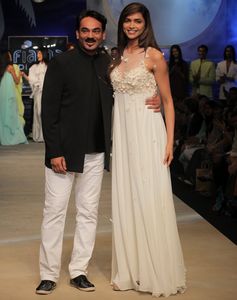India Fashion Week is now 25 years old. Never mind all the brand names that came before the term ‘India Fashion Week’—some have stayed, many have gone. The important thing is that season after season, in two cities at times, with two or three warring sponsors at times, India Fashion Week held its head above the water and sustained.
I was there for the first edition. It took place at The Taj Mahal Palace in Mumbai. It was such a glorious mix of fun fashions with some more elegant Indian dressing styles—a bit of a hodgepodge—but no one cared. There were after-parties every night. The most fun people from the fashion business were under one roof, vodka was on the house and gorgeous clothes were around us. No one knew how the event would shape up and no one cared. We were happy to be alive and happy to be in fashion.
The early years of what was then Lakme India Fashion Week saw some of the oldest names in the business. The late Wendell Rodricks presented one of the finest shows I had ever seen; one of the models (I think it was Deepti Gujral) wore a fish tank for a blouse with a full skirt. I couldn’t imagine anyone cut a garment the way Wendell could—even 25 years later, his scissors are the finest. Young and rebellious Goan Savio Jon descended upon Mumbai with his brand of irreverence. He sent out gorgeous little textile contemporary staples—something all of India is trying to do today—on his band of badass models. Diandra Soares and Binal Trivedi came up on the runway and gave each other a long deep kiss. The idea was just to shock and awe, but who knew nearly 20 years later homosexuality would be decriminalised in India.
Manish Malhotra (he looked the same) had Shah Rukh Khan (he looked so different) as his showstopper. Manish really brought on the magic that is the movie-star showstopper—from Urmila Matondkar to Kareena Kapoor. Everyone hated him for using his position as a costume stylist to bring his actor pals into fashion. But everyone realised that film and fashion cannot work without each other. And now any designer could dole out Rs25-50 lakh for a showstopper. No point arguing this, the Bollywood showstopper is unique to fashion weeks in India, and it has probably saved the fashion week from absolute irrelevance.
The idea behind forming a collective of fashion designers, called the Fashion Design Council of India, that presented the fashion weeks was to give the business the status of an organised industry. They would together and individually seek corporate support, to dress all of India in designers’ ready-to-wear clothes. There were no malls, no high streets, no designer districts, no luxury spaces, and no Indians at international fashion weeks. Now we have all of this. And within 20 years alone, corporate investments have come into fashion designers’ coffers making them super-brands.
There is of course still room for improvement. But I would say that about any fashion week anywhere in the world. There is always something that didn’t get finished on time, or something that could have been done better.
The most important thing is that India’s amazing fashion collective still exists. Sometimes applauding each other, other times at loggerheads; sometimes putting together outstanding innovative fashion, other times a collection that looks like it was designed 10 years ago. But it works together to give the country an ecosystem that is finding popularity and profit in India and abroad.
X@namratazakaria


